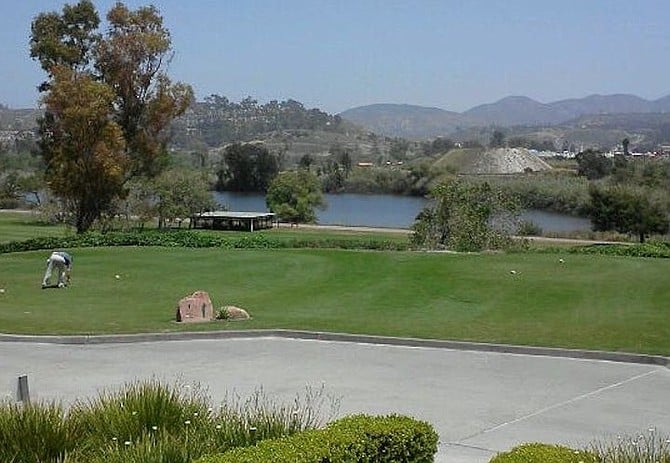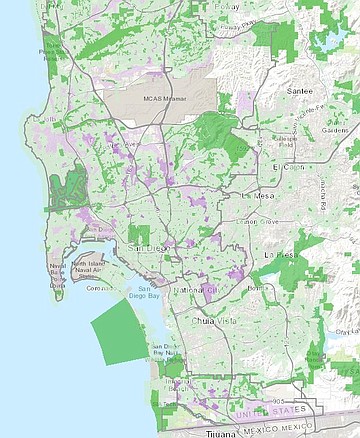 Facebook
Facebook
 X
X
 Instagram
Instagram
 TikTok
TikTok
 Youtube
Youtube

San Diego's vast park system has fallen from a top spot in a national ranking study due to a new factor used in 2021: equity.
Every year since 2009, the Trust for Public Land has been geeking out about the nation's largest city park systems, even nailing down the location of park entrances and physical obstacles to access, such as roads and rivers.

The goal is "to ensure there's a park within a 10-minute walk of home" for everyone in America.
Besides equity and access, the report looks at investment, amenities, and acreage in its ParkScore Index.
Inspired by "the national awakening" on racial and economic disparity, the new equity measures compare neighborhoods of color vs. white neighborhoods and low-income vs. high income neighborhoods, considering per capita park space and 10-minute-walk park access.

To obtain a high score, like Washington, D.C. or St. Paul, Minnesota, disparities must be low or non-existent.
San Diego, with its 538 parks, often lands within the top 20. Now it's #27. The city scored highly on acreage, which is based on a city’s median park size, as well as access. For a majority of residents, a park is at most a 10-minute walk from home.
But that still leaves 257,640 residents who don't have the same opportunity.

In San Diego neighborhoods where most people identify as people of color, residents have access to 73 percent less park space than in mostly white neighborhoods (49 percent less in Chula Vista, which was 81st in the rankings).
Those in San Diego's low-income neighborhoods have access to 86 percent less park space than those in high-income neighborhoods.
From home to park, distance alone doesn't tell the whole story. So the rating system evaluates access by studying how easy it is to reach the park.
Does a highway block the path, turning a short stroll into a roundabout car trip? Unless there's a pedestrian bridge or other feature to allow crossing, that park isn't counted as accessible to area residents.
In San Diego, for example, there's Cedar Ridge Park, separated from Gateway/Fairmount Park by I-15. Another is Admiral Baker Park & Elanus Canyon, which are cut off from Grantville by Friars Road.
City parks didn't score highly on amenities like dog parks, either, having only 1.2 per 100,000 people. Boise, Idaho, by contrast, has 6.3 per 100,000 residents.
However, San Diego has reserved 19 percent of its city area for parks, more than double the national ParkScore average.


San Diego's vast park system has fallen from a top spot in a national ranking study due to a new factor used in 2021: equity.
Every year since 2009, the Trust for Public Land has been geeking out about the nation's largest city park systems, even nailing down the location of park entrances and physical obstacles to access, such as roads and rivers.

The goal is "to ensure there's a park within a 10-minute walk of home" for everyone in America.
Besides equity and access, the report looks at investment, amenities, and acreage in its ParkScore Index.
Inspired by "the national awakening" on racial and economic disparity, the new equity measures compare neighborhoods of color vs. white neighborhoods and low-income vs. high income neighborhoods, considering per capita park space and 10-minute-walk park access.

To obtain a high score, like Washington, D.C. or St. Paul, Minnesota, disparities must be low or non-existent.
San Diego, with its 538 parks, often lands within the top 20. Now it's #27. The city scored highly on acreage, which is based on a city’s median park size, as well as access. For a majority of residents, a park is at most a 10-minute walk from home.
But that still leaves 257,640 residents who don't have the same opportunity.

In San Diego neighborhoods where most people identify as people of color, residents have access to 73 percent less park space than in mostly white neighborhoods (49 percent less in Chula Vista, which was 81st in the rankings).
Those in San Diego's low-income neighborhoods have access to 86 percent less park space than those in high-income neighborhoods.
From home to park, distance alone doesn't tell the whole story. So the rating system evaluates access by studying how easy it is to reach the park.
Does a highway block the path, turning a short stroll into a roundabout car trip? Unless there's a pedestrian bridge or other feature to allow crossing, that park isn't counted as accessible to area residents.
In San Diego, for example, there's Cedar Ridge Park, separated from Gateway/Fairmount Park by I-15. Another is Admiral Baker Park & Elanus Canyon, which are cut off from Grantville by Friars Road.
City parks didn't score highly on amenities like dog parks, either, having only 1.2 per 100,000 people. Boise, Idaho, by contrast, has 6.3 per 100,000 residents.
However, San Diego has reserved 19 percent of its city area for parks, more than double the national ParkScore average.
Comments